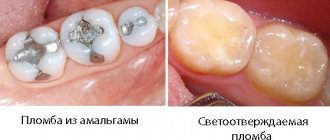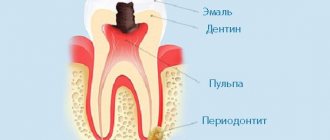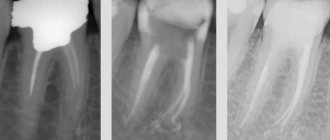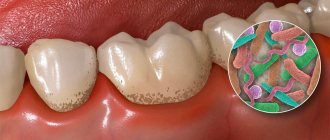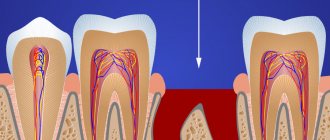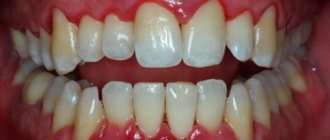Why does my tooth hurt after root canal filling? Pain syndrome in most cases is considered normal, which passes quickly and does not entail negative consequences. Sometimes, due to the inattention of the doctor, the process of shrinkage of the filling, due to the entry of a foreign body into the socket, and for other reasons, pain can persist for a very long time, until the provoking factors are completely eliminated.
Non-pathological pain can be dealt with independently at home. For this purpose, pharmaceutical preparations and folk remedies are used. Before using any formulations (both pharmaceutical and herbal), you should always consult your doctor.
Why are canals cleaned and sealed?
As is known, caries in the early and late stages differs in the depth of the lesion, where first a small dark spot is visible on the surface of the crown, and then grows very deep into the tissue. For this reason, therapeutic tactics depend on the size of the carious area. Sometimes it is enough for the dentist to remove the damaged area of the tooth, apply a special compound and fill the resulting hole. In such a situation, one session will be enough, the procedure will take little time, and pain relief may not be required.
When the pathology reaches the pulp, it is impossible to avoid removing the nerves and subsequent cleaning of the canals, treating them with an antiseptic, filling them with composites, as well as installing filling material or orthopedic structures. Before proceeding to the final stage of recovery, it is necessary to eliminate the inflammatory process. If you make mistakes during medical intervention or do not follow the treatment technology, the inflammation will return very quickly and discomfort will appear.
Prevention
You will greatly help yourself if you practice good hygiene regularly. They are extremely simple - brush your teeth twice a day, rinse if necessary.
Visit your dentist for checkups twice a year. With this type of examination, the doctor will certainly notice in time possible troubles - beginning caries, crumbling old filling.
Get your teeth professionally cleaned. This is especially true for those who are prone to stone formation and who have been diagnosed with periodontal disease or periodontitis.
When pain is normal
Discomfort after dental procedures does not always indicate that the doctor did something wrong. In itself, such an intervention is quite painful, so local anesthesia is required. The patient does not feel the unpleasant effects of the instruments during the session. When the effect of the painkiller wears off, pain appears.
Cement can also lead to this. As it hardens, it undergoes compression and affects the coronal part. In what cases should you not sound the alarm:
- after treatment, canal filling, the tooth hurts when pressed, as well as when eating too cold, hot, sour, spicy, sweet foods and liquids;
- the pain goes away when the irritating factor is eliminated;
- discomfort persists for up to 5 days, but no more, it becomes easier every day;
- there are no other suspicious symptoms.
If the treatment was difficult due to the severity of the pathological process, pain may be felt for up to 2 weeks. The dentist must warn you about this. Most likely, the patient will need a second visit to the clinic to rule out complications.
Content:
- When is a non-permanent filling indicated?
- Why does a tooth with a temporary filling hurt?
- When to sound the alarm
- What to do if a tooth hurts under a temporary filling
- Preventive measures
Most often, people rush to the dental clinic because of pain.
Naturally, every person hopes that he will return home with a healthy tooth. Unfortunately, this is not always the case. Often in dental practice there are situations when the doctor has to put a temporary filling instead of a permanent one. It is distinguished by its low cost and loose structure. It is loosely held in the carious cavity and quite quickly falls out on its own or decreases in volume. These features are due to the fact that the temporary filling material must be easily removed. The problems it solves:
- protection of the carious “hollow” from the accumulation of food debris and the penetration of pathogenic bacteria;
- preventing premature loss of medication from the “hole”.
Why do sealed tooth canals hurt?
Common pathological and non-pathological factors that lead to unpleasant symptoms:
- Violation of the technological process. This includes overdrying or underdrying of the dentinal cavity, and burns from a polymerization lamp.
- Poor quality filling (when the composite material has not completely filled the voids, the cement extends beyond the contours of the coronal part, the root is perforated, a foreign object is present).
- Allergy to any of the components of the formulations used.
- Patient has problems with bite.
- Depressurization of the seal. When one edge comes off or a small fragment breaks off.
- Complications arose after treatment. For example, caries appeared again, the nerve became inflamed, and a cystic neoplasm formed.
Overdrying (underdrying) of dentin
When the blackened carious tissues are eliminated, the hole is treated with a special solution, which should be absorbed into the dentin layer and provide high-quality adhesion to the filling material. It is necessary to pre-dry the surface, since saliva will interfere with the action of the applied composition.
If there is insufficient drying, the seal holds weakly, and the risk of its depressurization and mechanical damage when chewing food increases significantly. Pathogenic microorganisms can penetrate inside and cause recurrent caries.
Overdried fabrics do not adapt to the cement composition. The fact is that the processes occurring in them in this case slow down or stop completely.
Lamp burn
Can a tooth hurt after root canal filling (filling) with a light-curing filling? This is possible if overheating of hard tissues occurs during its application. When exposed to high temperatures, incisors, canines and molars are sometimes injured and destroyed.
Perforation
Before filling the unit, the doctor cleans the formed tubules using special needles. In this way, remnants of nerves, pus, tissues that have undergone necrosis and other unnecessary structures are removed. The dentist may accidentally puncture one of the bends. As a rule, such problems are solved quickly with the use of dental adhesive. An inexperienced physician may not pay attention to this and seal the perforated area. As a result, the cement will go beyond its limits and cause severe discomfort to the patient.
Shrinkage of the filling
The hardened composite contracts over time. However, it is very firmly attached to the inner walls of the socket, so it pulls hard tissue along with it. Microscopic cracks form. Don’t worry, dentin will grow naturally, but at the very beginning air masses will penetrate into the gaps formed, irritating the nerve endings.
Foreign body
Dental instruments are quite fragile, so sometimes their fragments can fall into the cavity when broken. If a specialist notices the problem in time, he can easily remove the broken piece or hermetically seal the area where it has penetrated. When the doctor does not notice the breakdown, after completion of therapy the tissues may become inflamed and the patient will experience pain.
Allergy
When a tooth pulsates after canal filling, individual intolerance to the components of the compositions used should not be ruled out. This also happens in the presence of galvanic current. The metal elements of dentures, orthodontic structures and filling particles begin to interact with each other, and an allergic reaction occurs.
Malocclusion
If the anesthesia is still in effect, it will be difficult for a patient with a similar problem to tell how comfortably the teeth will close together after the procedure. Some are even embarrassed to say that not everything is okay. As a result, the filling material extends beyond the crown, and the opposite one presses harder than usual.
Depressurization
This phenomenon is most often observed for the reasons listed above. Under external influence, one of the edges of the seal moves away from the surface, and the seal is broken. The unprotected contents of the hole are exposed to aggressive stimuli and respond to this with pain.
Repeated caries
Why does a tooth hurt or ache after root canal filling if the dentist did not clean the cavities well or treated them poorly? In the pathological area, pathogenic microorganisms accumulate, which cause secondary carious lesions. They multiply intensively under the filling, reaching dentin and nerves.
Pulpitis
A serious complication accompanied by damage to nerve fibers. Pathology is caused not only by doctor’s mistakes, but also by internal inflammatory processes formed in voids with foreign objects (a fragment of an instrument, a crown).
Root cyst or granuloma
As a rule, such neoplasms occur when pulp inflammation is diagnosed, when decay products penetrate into the root part. The pain syndrome is quite strong. It is necessary to conduct diagnostic studies, in particular radiography.
Preventive measures
In order for the process of preparing for the main treatment to proceed without unpleasant surprises and dangerous complications, you must follow simple rules:
- Try not to put stress on the sealed unit. This means that you should chew food from the “healthy side”. Under no circumstances should you chew on foreign objects. Also, intensive rinsing should not be done unless prescribed by a doctor.
- Maintain good oral hygiene. It is necessary to carry out hygiene measures in the morning and evening. Inflamed areas of the gums can be treated with a brush with soft bristles.
- Check the temporary filling for cracks and chips. If they appear, a re-sealing should be carried out. Otherwise, by the time the permanent material is installed, there may be nothing left of the dental crown - it will collapse under the aggressive influence of pathogens.
Watch your tooth filled with a temporary filling carefully. Then you will avoid many problems.
Features of installation: pain under temporary filling
In severe cases (for example, with advanced caries, complicated by an inflammatory process), one visit to the dental office is not enough to solve the problem. During the first visit, the specialist performs sanitation, cleans the tooth cavity and administers medication. This can be an antimicrobial composition or a remedy that eliminates inflammation and regenerates dentin tissue.
Sometimes it is necessary to “kill” the nerve. To do this, a special paste-like substance is applied. To prevent pathogenic microorganisms from getting inside, it is necessary to seal the hole with a temporary filling. The person should wear it until their next visit to the dentist. All this time, pain and other discomfort may be present. In some cases, this is considered a variant of the norm; in other situations, such signs indicate that the medications cannot fully cope with the task. Depending on the patient’s complaints and clinical picture, the doctor develops further therapeutic tactics.
When to sound the alarm
Is it normal for a tooth with a temporary filling to hurt a lot? No. Mild discomfort is possible, but long-lasting acute pain is a reason to visit the doctor again. However, this should be done as soon as possible. It is especially dangerous if a person’s well-being worsens at night, swelling has formed or a purulent “bump” has appeared - all this may indicate the rapid progression of dangerous complications.
What kind of pain can there be and what problem does it indicate:
- The tooth aches constantly. The state of health after the last visit to the dentist does not worsen, but does not improve either. This is possible if you are allergic to a dental composition, use too high a dose of the drug (intoxication occurred due to an overdose), or use a very low dose of the drug (the infection could not be stopped and it continues to actively progress).
- Discomfort appears only when pressing on the diseased unit. Here one should suspect traumatic damage to the periodontium due to the artificial overestimation of the dental crown.
- Unbearable pain appears even with a slight touch to the tooth. Perhaps a fragment of a medical instrument remains in the canal or acute periodontitis has developed.
- There are attacks of pain. This happens when the purulent form of pulpitis is advanced.
How pain is treated
Nobody wants to go through drilling with a drill again. However, what to do if the canals are filled and the tooth hurts? In some cases, tissue reaming is no longer required: physiotherapeutic procedures are sufficient to relieve pain. This therapy is indicated when the integrity of the dentinal layer is damaged during drying.
If pain occurs due to protrusion of the filling material, the excess part will be carefully removed. In case of an allergic reaction, it is important to establish which component caused it and find a worthy alternative.
What do patients do after root canal filling?
In order for the recovery period to pass quickly and without problems, it is necessary to adhere to certain rules and follow all medical recommendations. First of all, it is important to minimize the external impact on the sealed dental unit and perform hygiene procedures daily.
Preventive measures to help prevent complications:
- refusal of very cold and hot, too hard, sour foods in favor of soft foods at room temperature for a week;
- wearing warm clothing appropriate for the weather to reduce the risk of hypothermia;
- elimination of bad habits (smoking, drinking alcohol);
- Regular brushing with a toothbrush with soft bristles.
You should not use whitening pastes, especially those containing abrasive particles. After eating, it is recommended to rinse your mouth with a special mouthwash.
Classic filling
The conventional filling procedure does not imply penetration into the tooth pulp and depulpation of the root canals. This manipulation is much simpler compared to endodontic intervention, however, not everything is so obvious here. First, conventional therapeutic procedures are performed more frequently. Secondly, the quality of materials and the level of specialists in Russia are often low, so severe pain after filling a tooth and other complications are by no means uncommon even with the simplest manipulations. Below is a table that describes the most common causes of complications and pain after filling.
| Type of complication | Description | Pain symptoms |
| Mechanical trauma to the pulp during filling (pulp perforation) | It occurs when the bur is used roughly and carelessly, when the partition between the pulp and dentin is destroyed. Modern dentistry offers conservative ways to eliminate such complications, but often only a depulpation procedure can help. | With this problem, the tooth “pulsates” after filling and reacts sharply to cold and hot. The pain is severe and practically does not subside. |
| Burn of dentin or pulp (tooth overheating) | Usually occurs when the cooling system of the drill malfunctions, when the tooth tissue gets burned during the operation of the drill. In the most severe cases, the patient develops pulpitis and periodontitis. | If your tooth ache after filling and the pain does not go away for a long time, it is quite possible that you have a dentin burn. If, after filling, the tooth reacts sharply to hot and cold or there is throbbing pain, then most likely the pulp was affected. |
| Incorrectly installed seal | Overbite and overhanging filling edges are among the most common causes of pain. Incorrect closure of the dentition provokes very unpleasant sensations. | Does your tooth hurt when you bite it after filling? Perhaps the problem is an incorrectly installed seal. If the cause is not eliminated in time, the tooth reacts painfully even with gentle pressure. |
| Error when choosing material | There are more than a dozen filling materials on the market, many of which are not suitable for everyone due to their properties and components. | Acrylic composite and silicate cement fillings can cause allergies and inflammation. Amalgams and some light fillings can shrink, which is why the tooth hurts quite noticeably when bitten after filling. |
| Gum injuries | Damage to soft tissue is a very common occurrence during therapeutic manipulations (especially in the treatment of cervical caries). Serious injuries may require gum grafting. | Aching or cutting pain at the site of gum damage. |
Why does a tooth hurt after root canal cleaning?
Pain is present in 95% of all patients who have undergone such manipulations. Unpleasant sensations arise due to the impact on soft and hard tissues, as well as due to injury to the gums.
Factors that lead to discomfort:
- An advanced pathological process and, as a result, a late visit to the dental clinic.
- The presence of serious inflammation. The voids are cleared, but the inflamed structures remain.
- Individual intolerance to components. Expressed by swelling, itching, redness, hyperemia. There are signs of allergic rhinitis.
- There was a tooth fragment left inside.
- The filling was carried out with violations. For example, the root is perforated, or the cement composition has gone beyond the permissible limits.
When it's not ok
How long can a tooth normally ache after root canal treatment? Why is it worth sounding the alarm if the condition does not return to normal? Usually the pain goes away after 2-3 days, but sometimes the discomfort persists for some time. You should be wary if your health only worsens or does not change within several days. Why this might happen:
- cleaning was performed poorly;
- the filling compound has gone beyond the root tip;
- a fragment of enamel or a fragment of a dental instrument remains in the cavity;
- the root is perforated;
- signs of an acute allergic reaction appeared.
Under no circumstances should you self-medicate. It is important to consult a doctor as soon as possible to develop further treatment tactics.
Gums hurt after root canal cleaning
Discomfort can be felt not only at the site of intervention, but also in the gum tissue. Causes:
- dentist mistakes;
- anatomically incorrect structure of the unit;
- the physician left the cavity uncleaned;
- a medical instrument broke during treatment;
- the fibers are mechanically damaged, swelling appears;
- inflammation of the trigeminal nerve was diagnosed;
- the pathological area was cleaned poorly.
The temperature has risen
If the patient sees a reading of 37-38 degrees on the thermometer, then the immune system perceives tools and materials as foreign bodies and starts the rejection process.
Why the normal temperature regime may be disrupted:
- inflammation has begun;
- a viral or bacterial infection has joined;
- tissues are injured;
- treatment was carried out for a cold or other illness.
It happens that before visiting a dental clinic, a patient is too worried. Stress also causes a rise in temperature. Normally, it can remain at a level of 37-37.4 for 1-2 days. If symptoms persist, it is important to visit a doctor as soon as possible.
Treatment of post-filling pain
Home treatment for pain that occurs after filling is fraught with serious complications. If a surgical visit to the doctor has to be postponed for several days (when the pain catches you on vacation or on a business trip), you can temporarily suppress it with the help of:
- rinsing with herbs (decoctions of chamomile, calendula, sage have a calming effect);
- disinfection with antiseptics (rinsing, using spray).
Painkillers and anti-inflammatory drugs should be taken with caution, always in accordance with the instructions.
You should never put off going to the doctor. But in some cases this needs to be done immediately. Delay is dangerous when:
- the pain has become unbearable;
- the temperature has risen;
- inflammation began (gums, cheeks);
- lymph nodes have enlarged;
- abscesses have formed.
Incomplete treatment can lead to serious complications: the development of pulpitis, tissue necrosis, tooth destruction and loss. Therefore, try not to lose contact with your doctor until the post-filling recovery period has passed.
Number of views 3,539
How to help yourself at home
It is better not to self-medicate and consult with specialists even about harmless compounds. One of the main rules is not to apply heat to the treated area (hot drinks, compresses, do not visit baths, saunas).
Drug therapy
When a tooth hurts after cleaning and filling the canals, analgesics and anti-inflammatory drugs, for example, Analgin, Nurofen, Nise, Tempalgin, come to the rescue. Only a doctor should prescribe medications and calculate acceptable dosages. In addition, before taking it, you should carefully study what is indicated in the instructions for use.
Traditional methods
Home medicine also helps to cope with unpleasant symptoms. It is recommended to apply clove oil, fir oil or lemon balm infusion (a few drops) to a cotton pad or swab and apply to the sore spot for 7-10 minutes. Some people prefer to use ice for this, but the effect does not last long. You can also lightly massage the auricle on the aching side.
What not to do
The first thing you absolutely cannot do is heat the sore spot. Inflammation may intensify, swelling and tissue pressure on the nerve will increase. The pain will very quickly become unbearable.
It is also not recommended to apply cold objects - ice or a piece of frozen meat, as this will only make things worse.
Do not attempt to open the tooth yourself. You are unlikely to succeed, but you can break it with almost a 100% guarantee. This means that after treatment you will have to go to prosthetists.
Important
. Uncontrolled use of antibiotics without a doctor's prescription is excluded.


